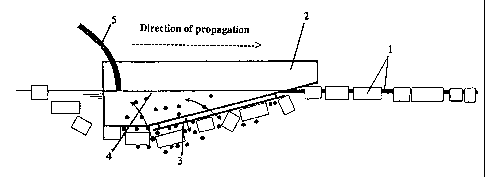Some of the information on this Web page has been provided by external sources. The Government of Canada is not responsible for the accuracy, reliability or currency of the information supplied by external sources. Users wishing to rely upon this information should consult directly with the source of the information. Content provided by external sources is not subject to official languages, privacy and accessibility requirements.
Any discrepancies in the text and image of the Claims and Abstract are due to differing posting times. Text of the Claims and Abstract are posted:
| (12) Patent: | (11) CA 2366220 |
|---|---|
| (54) English Title: | METHOD AND DEVICE FOR COLLECTING OIL MIXED WITH ICE BLOCKS |
| (54) French Title: | PROCEDE ET DISPOSITIF DE RECUPERATION DE PETROLE MELANGE A DES BLOCS DE GLACE |
| Status: | Expired and beyond the Period of Reversal |
| (51) International Patent Classification (IPC): |
|
|---|---|
| (72) Inventors : |
|
| (73) Owners : |
|
| (71) Applicants : |
|
| (74) Agent: | OYEN WIGGS GREEN & MUTALA LLP |
| (74) Associate agent: | |
| (45) Issued: | 2006-01-31 |
| (86) PCT Filing Date: | 2000-03-13 |
| (87) Open to Public Inspection: | 2000-09-14 |
| Examination requested: | 2002-03-08 |
| Availability of licence: | N/A |
| Dedicated to the Public: | N/A |
| (25) Language of filing: | English |
| Patent Cooperation Treaty (PCT): | Yes |
|---|---|
| (86) PCT Filing Number: | PCT/FI2000/000195 |
| (87) International Publication Number: | WO 2000053488 |
| (85) National Entry: | 2001-09-10 |
| (30) Application Priority Data: | ||||||
|---|---|---|---|---|---|---|
|
The objective of the present invention is a method and a device for separating
oil from ice. In the method according to the invention,
ice is pressed under the water along an inclined surface formed by a bar
screen (3) or a grating. The oil is separated from the ice by
vibrating the inclined surface formed by the bar screen (3).
La présente invention concerne un procédé et un dispositif servant à séparer le pétrole de la glace. Selon le procédé de l'invention, la glace est poussée sous l'eau le long d'une surface inclinée formée par une grille à barreaux (3) ou un grillage. On sépare ensuite le pétrole de la glace en faisant vibrer la surface inclinée formée par la grille à barreaux (3).
Note: Claims are shown in the official language in which they were submitted.
Note: Descriptions are shown in the official language in which they were submitted.

2024-08-01:As part of the Next Generation Patents (NGP) transition, the Canadian Patents Database (CPD) now contains a more detailed Event History, which replicates the Event Log of our new back-office solution.
Please note that "Inactive:" events refers to events no longer in use in our new back-office solution.
For a clearer understanding of the status of the application/patent presented on this page, the site Disclaimer , as well as the definitions for Patent , Event History , Maintenance Fee and Payment History should be consulted.
| Description | Date |
|---|---|
| Time Limit for Reversal Expired | 2020-03-13 |
| Common Representative Appointed | 2019-10-30 |
| Common Representative Appointed | 2019-10-30 |
| Letter Sent | 2019-03-13 |
| Inactive: Late MF processed | 2007-03-19 |
| Letter Sent | 2007-03-13 |
| Grant by Issuance | 2006-01-31 |
| Inactive: Cover page published | 2006-01-30 |
| Pre-grant | 2005-11-18 |
| Inactive: Final fee received | 2005-11-18 |
| Notice of Allowance is Issued | 2005-06-29 |
| Letter Sent | 2005-06-29 |
| Notice of Allowance is Issued | 2005-06-29 |
| Inactive: Approved for allowance (AFA) | 2005-06-14 |
| Amendment Received - Voluntary Amendment | 2005-03-04 |
| Inactive: S.30(2) Rules - Examiner requisition | 2004-12-31 |
| Inactive: S.29 Rules - Examiner requisition | 2004-12-31 |
| Letter Sent | 2002-04-15 |
| Request for Examination Received | 2002-03-08 |
| Request for Examination Requirements Determined Compliant | 2002-03-08 |
| All Requirements for Examination Determined Compliant | 2002-03-08 |
| Inactive: Cover page published | 2002-02-15 |
| Letter Sent | 2002-02-15 |
| Inactive: Notice - National entry - No RFE | 2002-02-15 |
| Inactive: First IPC assigned | 2002-02-13 |
| Application Received - PCT | 2002-01-30 |
| Application Published (Open to Public Inspection) | 2000-09-14 |
There is no abandonment history.
The last payment was received on 2005-02-18
Note : If the full payment has not been received on or before the date indicated, a further fee may be required which may be one of the following
Please refer to the CIPO Patent Fees web page to see all current fee amounts.
Note: Records showing the ownership history in alphabetical order.
| Current Owners on Record |
|---|
| SUOMEN YMPARISTOKESKUS |
| Past Owners on Record |
|---|
| ERKKI MYKKANEN |